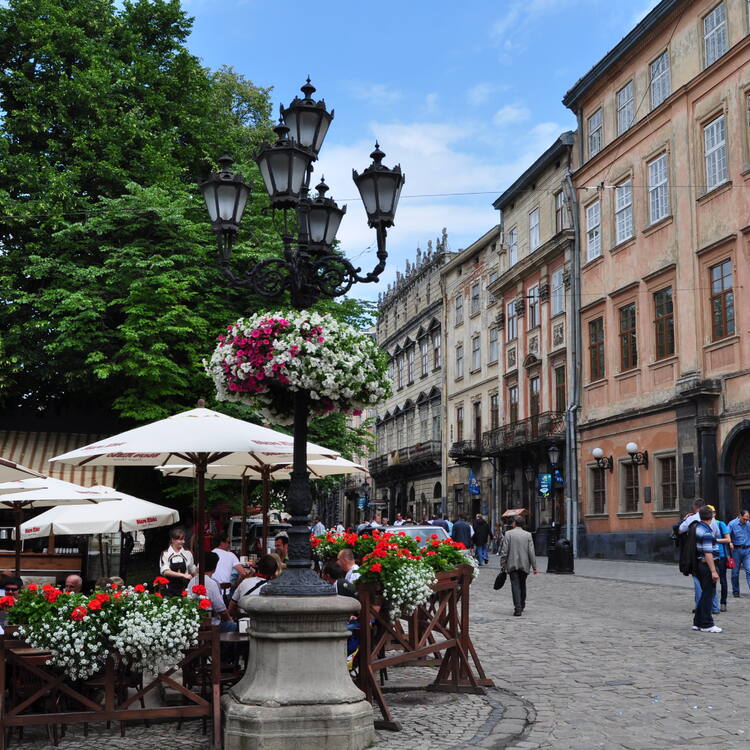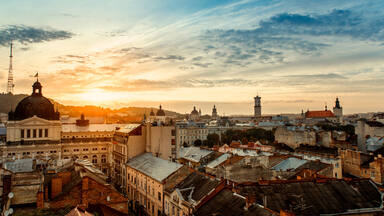L'viv – the Ensemble of the Historic Centre
L'viv – the Ensemble of the Historic Centre
The city of L''viv, founded in the late Middle Ages, was a flourishing administrative, religious and commercial centre for several centuries. The medieval urban topography has been preserved virtually intact (in particular, there is evidence of the different ethnic communities who lived there), along with many fine Baroque and later buildings.
Description is available under license CC-BY-SA IGO 3.0
Lviv – ensemble du centre historique
La ville de Lviv, fondée à la fin du Moyen Âge, s''est épanouie en tant que centre administratif, religieux et commercial pendant plusieurs siècles. Elle a conservé virtuellement intacte sa topographie urbaine médiévale, et en particulier la trace des communautés ethniques distinctes qui y vivaient, ainsi que de magnifiques bâtiments baroques et plus tardifs.
Description is available under license CC-BY-SA IGO 3.0
لفيف - مجمع الوسط التاريخي
ازدهرت مدينة لفيف التي تأسست في نهاية القرون الوسطى كمركز اداري وديني وتجاري على مدى عصور عدة. وقد حافظت على طوبوغرافيتها المدنية العائدة الى القرون الوسطى ولا سيما على آثار المجتمعات الإثنية المختلفة التي كانت تسكنها، كما أبقت على أبنية رائعة من الحقبة الباروكية وما بعدها.
source: UNESCO/CPE
Description is available under license CC-BY-SA IGO 3.0
里沃夫历史中心
里沃夫建于中世纪后期,作为政治、宗教和商业中心繁荣了好几个世纪。中世纪的城市地形被完好无缺地保存下来,特别是反映不同的民族在此居住的证据。这里还有许多精巧的巴洛克风格建筑及其后的建筑。
source: UNESCO/CPE
Description is available under license CC-BY-SA IGO 3.0
Ансамбль исторического центра Львова
Львов, основанный в позднем средневековье, на протяжении нескольких веков являлся процветающим административным, религиозным и торговым центром. Средневековая планировка города сохранилась до наших дней практически без изменений (в частности, сохранились свидетельства о живших здесь различных этнических общинах). Также уцелело множество прекрасных барочных и более поздних зданий.
source: UNESCO/CPE
Description is available under license CC-BY-SA IGO 3.0
Lvov – Conjunto del centro histórico
Fundada a finales de la Edad Media, la ciudad de Lvov llegó a ser un importante centro administrativo, religioso y comercial, cuya influencia iba a perdurar en los siglos posteriores. La ciudad ha preservado prácticamente intacta su topografía urbana medieval y, en particular, la huella de las diferentes comunidades que la han habitado. También ha conservado magníficos edificios del periodo barroco y de épocas posteriores.
source: UNESCO/CPE
Description is available under license CC-BY-SA IGO 3.0
リヴィフ歴史地区
中世後期に建設されたリヴィフは、数世紀の間、行政・宗教・商業の中心地として繁栄し、東欧やイタリア、ドイツの建築や芸術の伝統が融合した中世期の都市の姿をそのままの姿で残している。また、様々な文化や宗教を持った多くの民族が、リヴィフの恵まれた政治・経済に魅せられて集まった。そうした諸民族の文化が、独自にあるいは相互に影響し合いながら築き上げた居住域の姿が、見事なバロック建築とともに現在の街並みに認められる。source: NFUAJ
Historisch centrumgedeelte van L’viv
De stad L’viv werd opgericht in de late middeleeuwen en was gedurende enkele eeuwen een bloeiend administratief, religieus en commercieel centrum. De middeleeuwse stedelijke topografie is vrijwel helemaal intact gebleven, samen met mooie gebouwen uit de Barok en latere periodes. Er is ook bewijs van de etnische gemeenschappen die er woonden. De politieke en commerciële rol van L'viv trok Oekraïense, Armeense, Joodse , Duitse, Poolse, Italiaanse en Hongaarse groepen. Vanwege hun verschillende culturele en religieuze tradities vestigden ze zich afzonderlijk van elkaar, maar waren onderling afhankelijk. Het resultaat is een modern stadsbeeld met architectonische en artistieke meesterwerken waarin Oost-Europese tradities samensmelten met Duitse en Italiaanse.
Source: unesco.nl
Outstanding Universal Value
Brief synthesis
The city of L’viv was founded in the late Middle Ages where a settlement had existed since the 5th and 6th centuries. It flourished as an administrative, religious and commercial centre due to its favourable geographical position for trade and political development. Today, the surviving architectural and artistic heritage reflects a synthesis of Eastern European traditions influenced by those from Italy and Germany. The property, “L'viv – the Ensemble of the Historic Centre”, consists of two components: the primary area, encompassing the castle, its surrounding area and the city centre, and to the southwest, a smaller area on St. Yuri’s Hill for the ensemble of St. Yuri’s Cathedral.
L’viv’s historic centre includes many distinct parts representing different stages in its development. The Vysokyi Zamok (High Castle) and Pidzamche (area around the castle) are the main and oldest part of the town, dating to the 5th century. It retains its original topography with a hill, on which the castle sits, and lowlands on which a system of streets and squares developed between the 13th and 17th centuries. Evidence of occupation by separate ethnic communities is seen in the surviving buildings, including a mosque, a synagogue and a variety of religious buildings from the Orthodox, Armenian and Catholic churches.
The Seredmistia, or city centre, developed in the 14th century and features well-preserved Eastern European urban buildings, including many monasteries and residences of the Renaissance and Baroque traditions, as well as parks built on the original site of the medieval fortifications and more recent buildings dating from the last two centuries.
Located on a mountain plateau to the southwest of the medieval city is the Ensemble of St. Yuri. This complex was the heart of Halychyna Church Metropolis and features buildings primarily in Baroque-style with a high artistic value.
Criterion ii: In its urban fabric and its architecture, L’viv is an outstanding example of the fusion of the architectural and artistic traditions of Eastern Europe with those of Italy and Germany.
Criterion v: The political and commercial role of L’viv attracted to it a number of ethnic groups with different cultural and religious traditions, who established separate yet interdependent communities within the city, evidence of which is still visible in the modern townscape.
Integrity
The two component parts that form the ensemble of the historic centre of L’viv contain all the elements necessary to reflect its Outstanding Universal Value. The surviving buildings and ancient street pattern are able to illustrate the history of L’viv with its diverse ethnic and religious influences.
Threats to the property’s integrity have been identified, including excessive heavy vehicular traffic, the exodus of residents to the suburbs and inappropriate development. The latter is caused by a number of factors including inadequate funding, lack of education for owners and users of the architectural monuments, as well as deficiencies in the implementation of existing regulations.
Authenticity
The authenticity of the property is high. Its setting retains its characteristic topography with hills, plateaus and river valleys. This landscape continues to illustrate the traditional relationship between the defensive castle constructed on a hill and the town below. Moreover, the urban layout survives in the medieval street pattern, squares, major churches and ethnic communities. The parcel system of the historical city centre has been preserved despite numerous fires (in 1527 and 1571).
Authenticity of design is also found in the preservation of many early residences. This is visible in their interior layout, original materials in interior decoration, wall paintings, stained glass windows and exterior ornamentation. This is also seen in the exterior bricks and large-sized stone blocks used in construction.
Some loss of urban structure has occurred over time, mainly during the Second World War. However, the individual addition of later buildings (Ukrainian secession and modernism) has blended organically into the pre-existing ensemble.
Protection and management requirements
The area covered by the territory of L'viv – the Ensemble of the Historic Centre is included within the larger 3,000 hectare region that was designated as a National Historical and Architectural ·Preserve on 12 June 1975 by Resolution NQ 297 of the UkrSSR Council of Ministers under the provisions of the Law on Monuments of History and Culture (1970). The Law of Ukraine “On Protection of Cultural Heritage” (2000) is the main legislative document at the national level on which the property protection is based. The Council of Ministers has designated 209 historic monuments as National Landmarks within the inscribed territory and a number of others are declared as being of local importance by resolution of the Regional Administration. This legislation imposes strict control on any activities proposed within the protected area that may have an adverse impact on the Outstanding Universal Value.
Building ownership belongs to a variety of state, municipal and private parties. Overall supervision is the responsibility of the Department of Cultural Heritage and Cultural Monuments of the Ministry of Culture of Ukraine. At the local level, management is delegated to the Directorate of the L’viv City Council for the Protection of the Historic Environment. Advice relating to construction and restoration projects is provided by the Scientific Advisory Board, which is associated with the department and is composed of professionals in cultural heritage restoration as well as representatives of relevant community organizations (the charitable foundation Preservation of Historical and Architectural Heritage of L’viv and the Union of Architects). Recent construction activities within the property and its buffer zone that may affect the Outstanding Universal Value have been halted.
Management and property protection are carried out according to the Strategic Development Plan for the City of L’viv (2011-2025), part of an Integrated Concept of the Development of the Central Part of L’viv (2011-2020). This document identifies protective zoning for the historic area. A management plan for the World Heritage property is under development.
On the local level, each year a plan of restoration of monuments is approved, with particular attention to the public welfare of the territories and the reconstruction of engineering networks for the structures. Various programmes are offered at the municipal level. For instance, funding is provided for restoration of historic doors and windows. Additionally the joint Ukrainian-German project assists with training seminars to improve the skills of local craftsmen. Concern about heavy traffic within the historic centre is being addressed by restricting vehicles in certain areas and rerouting buses. Cycling infrastructure is also under development.
Links
-
Department of Historic Environment Protection (in Ukrainian only)
-
LKP Heritage Bureau in Lviv (in Ukrainian only)
-
Department of Historic Environment Protection Facebook page (in Ukrainian only)
-
Heritage Bureau in Lviv Facebook page (in Ukrainian only)
-
Heritage Bureau in Lviv Instagram account (in Ukrainian only)
-
Lviv City Council
-
Lviv City Council (in Ukrainian)
-
All About L'viv






